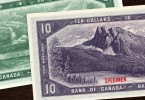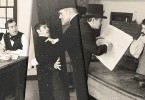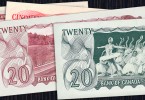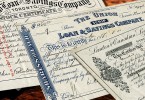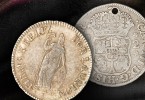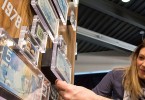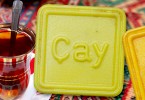Take a look inside your wallet. What symbols and themes are on the bank notes within? What do they represent to you? Imagine visitors from around the world using our currency—what story does it tell about Canada?
In our last blog post for teachers, we talked about the significance of the portrait on the new $10 bank note—but there’s a lot more to consider when designing a note that will be in the pockets of Canadians and international visitors alike. The theme for this $10 is social justice and human rights, inspired by the portrait subject, Viola Desmond.
Here is an idea about how you might use the symbols and themes of Canadian bank notes in a lesson about Canadian identity. You can use this as a follow-up lesson to For Teachers: How to Use the New Bank Note to Teach About Historical Significance, or it can stand alone. This activity is best suited for secondary and intermediate-level students studying Canadian history or civics.
Introduction
The Government of Canada invited Canadians to nominate the portrait subject of the new $10. Once Viola Desmond was chosen, a theme was developed for the note to reflect Viola’s story and what she represents to Canadians. Viola’s legacy was her challenge against racial segregation in 1940s Canada. This is the first time that the portrait subject on the front of a Canadian bank note has directly inspired the theme on the back. In this way, the bank note reflects something of value and inspiration to Canadians: our ongoing pursuit of equality, human rights and social justice.
As a class, examine the symbols and themes on the new $10 bank note. Nine symbols on the note complement Viola’s story and represent human rights in Canada:
- A historic map of Halifax’s North End
- The Library of Parliament’s dome ceiling
- The Canadian flag
- The Canadian Coat of Arms
- The Canadian Museum for Human Rights
- An eagle feather
- An excerpt of the Canadian Charter of Rights and Freedoms
- The laurel leaf, as seen in the Supreme Court of Canada
Assign a group of students to research each of these symbols, using the inquiry question: How does this symbol represent human rights or social justice in Canada? Some research links are included at the end of this blog post. Encourage students to think critically about their answers. As part of a follow-up discussion, you could ask students to brainstorm what other symbols they would include to represent human rights.
Reflecting Canada
Now your students will design their own bank notes. Show your class the Principles for Bank Note Design established by the Bank of Canada. In designing bank notes, the Bank is concerned with security, functionality, accessibility and bilingualism—but also that notes represent Canada:
Reflect Canada
Bank notes are a unique opportunity to represent Canada. Each note depicts new visual content so that, over time, the diversity of Canadian society, culture and achievements are celebrated. Bank notes:
- promote Canada and Canadians - our values, culture, history, traditions, achievements and/or natural heritage;
- are clearly identifiable as Canadian through the use of symbols, words or images;
- are meaningful to Canadians today and for years to come; and
- evoke pride and confidence in Canada.
To choose a theme for their bank notes, your class can do one of the following:
- brainstorm a list of what they consider to be Canadian values and achievements.
- choose an inspirational Canadian and pick a theme that corresponds to this person. Here is the long list of candidates nominated for the $10.
- look at the results of the Bank of Canada’s public consultation on the $10 bank note to choose a theme that Canadians have identified as being important to them.
In groups, students choose a theme and corresponding Canadian symbols to represent that theme. Encourage students to think of symbols that reflect different Canadian cultures and different parts of the country. Their bank note should include between 7 and 10 symbols, including a portrait of an inspirational Canadian.
Students can present their bank notes to the class and explain the theme, symbols and values that they represent.
Extensions
- Examine the complete series of bank notes issued by the Bank of Canada since its founding in 1935. Using the historical thinking concept of continuity and change, answer the inquiry question: How has the way that Canadian identity is presented on bank notes changed or remained the same over the last century?
- Use the Bank of Canada’s Fraud Prevention Kit to examine the security features of bank notes and have your students improve the security of their notes to deter counterfeiting.
Research sources
Halifax’s North End
“North End, Halifax,” Wikipedia
“Halifax,” The Canadian Encyclopedia
“Halifax and Its People: 1749–1999,” Nova Scotia Archives
The Library of Parliament
“Library of Parliament,” Library of Parliament
“Library of Parliament,” The Canadian Encyclopedia
The Canadian flag
“History of the National Flag of Canada,” Government of Canada
“The Flag Turns 50,” Canada’s History
The Canadian Coat of Arms
“Official symbols of Canada,” Government of Canada
“Emblems of Canada,” The Canadian Encyclopedia
The Canadian Museum for Human Rights
“About the Museum,” The Canadian Museum for Human Rights
“Canadian Museum for Human Rights,” The Canadian Encyclopedia
Eagle feather
“Rights of Indigenous Peoples in Canada,” The Canadian Encyclopedia
“The feather, Elijah Harper and Meech Lake,” Aboriginal Multimedia Society
“Indigenous Perspectives Education Guide,” Historica Canada
“First Peoples of Canada: Presenting the history and continuing presence of Aboriginal people in Canada,” The Canadian Museum of History
The Canadian Charter of Rights and Freedoms
“Constitution Acts, 1867 to 1982,” Justice Laws Website
“Your Guide to the Canadian Charter of Rights and Freedoms,” Government of Canada
“Canadian Charter of Rights and Freedoms,” The Canadian Encyclopedia
The Supreme Court of Canada
“Welcome to the Supreme Court of Canada,” Supreme Court of Canada
“Supreme Court of Canada,” The Canadian Encyclopedia
We want to hear from you
Comment or suggestion? Fill out this form.
Questions? Send us an email.
The Museum Blog
The 1954 series: the artwork of Charles F. Comfort
By: David Bergeron
Swindle! Canadian Phantom Banks
By: Graham Iddon
Vignettes for a $1,000 bank note that never was
By: David Bergeron
New Acquisitions
By: Paul S. Berry
New Acquisitions
By: Raewyn Passmore
The Adventure of Exhibit Planning IX
By: Graham Iddon
An Exhibition Installation
By: Graham Iddon
New Acquisitions
By: Raewyn Passmore
